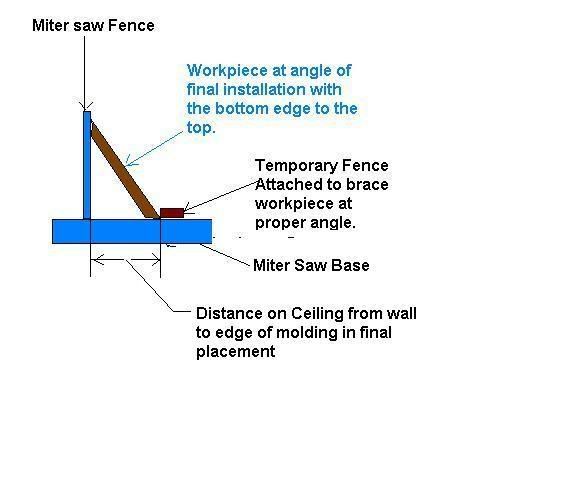General Guidelines
What material is the crown made of?
Wood – Cope (unless painting)
MDF – Miter
Will the crown be stained or painted?
Stain – Cope
Paint – Miter
Adjusting for out of plumb?
Not a lot you can do about the ceiling except use a sander to trim the back of the crown or if it’s a lighter material bend it to position.
Coping, closing your corners?
Cope the crown in position. If you’re laying it flat then the top corners will never match because you’re ignoring the spring angle when coping.
92 degree wall – How to measure Miter?
Assuming you’re using a crown jig (otherwise becomes compound angles) you have the crown body to your left meaning you’re cutting the right edge of the crown.
The actual angle that you’re dealing with is 360 degrees, but your saw and the walls reduce it to a manageable 270/180/90. 270 is an outside corner, 180 is a flat wall and 90 is an inside corner.
Now picture a circle, a pizza works well for this. If the wall is greedy it takes up most of the pizza, leaving you with one quarter or 90 degrees. If the wall is a nice guy then it leaves you most of the pizza or 270 degrees.
The miter saw lets you decide if the wall should get most of the pizza or if you should. Equal (0 degree miter) is a flat cut. Unless you’re coping, sadly you’ll never use this setting, but then again life is rarely fair for you or walls.
The bulk of your work piece is to your left, meaning it will occupy the right side of an angle. We’ll stick with the pizza thing because it’s near lunch. So, the pizza is to your left and you want to be a nice guy so you give most of the pie to the wall by moving the miter to the left. If you’re feeling like a jerk then take most of it by moving the miter to the right. The exact opposite is true if the pizza is to your right, left to take more and right to take less.
At this time I suggest using a mimetic to help yourself out. I don’t have a good one so you can just scream “screw you wall” if you’re going to take most of the pizza (outside corner) or “okay, this time you get it all” if you’re giving the wall most of it (inside corner)
So, joking aside your angles are either 90 degrees of the circle representing an inside corner or 270 degrees for an outside. A flat piece is always 180. You’re either subtracting from that 180 to make an inside corner or adding to make an outside.
A perfect outside corner is 180+90 = 270
A perfect inside corner is 180-90=90
So if your inside wall is a little open, say the 92 degrees you had, the angle is 180-92=88. Divided by 2 your miter angle is 44. If the wall is just a bit closed, say 88 degrees then that angle becomes 46.
Outside corners work in the exact opposite direction. A slightly smaller than 90 degree wall means you need a bit more to 180 to make the angle fit. An outside corner that shows on a protractor as 88 degrees means the actual angle is 360-88 (occupied space) so 272. 180 is always fixed so 272-180=92. Divide that by two and you get a miter angle of 46 degrees. A corner that is a bit fatter decreases the cut angle to 44.
Other things to consider
If you’re using a painted pine or mdf you can always use caulk to close mitered joints. If it’s a stained wood things are a little more delicate. You can use stainable wood filler or a filler stick, but your corners have to allow for minor wood movement. Also, with an imperfect cope you still get one great view angle and one so-so angle. With an imperfect miter you get nothing but bad viewing angles.







